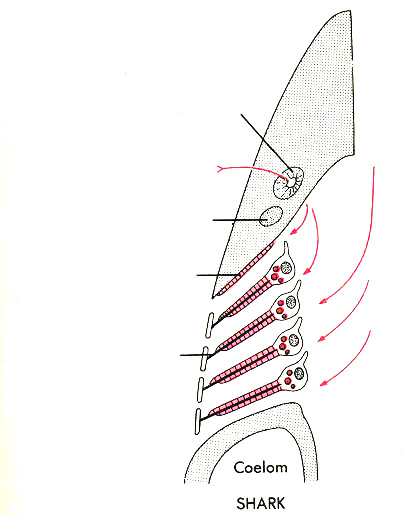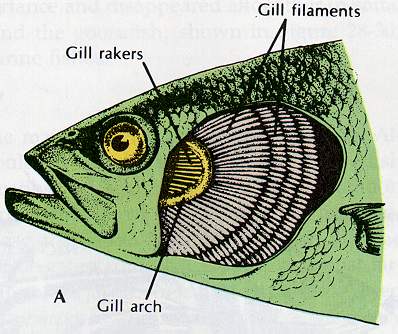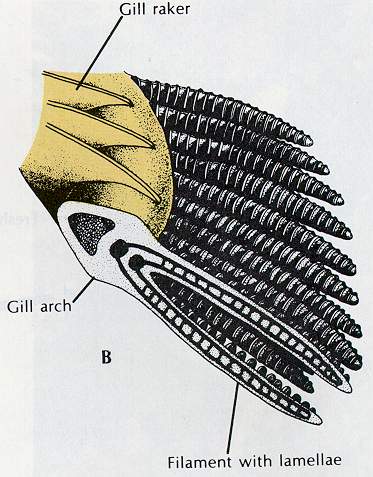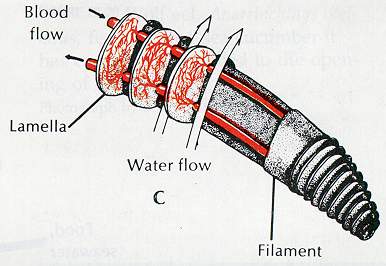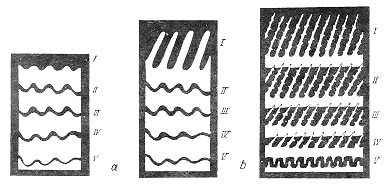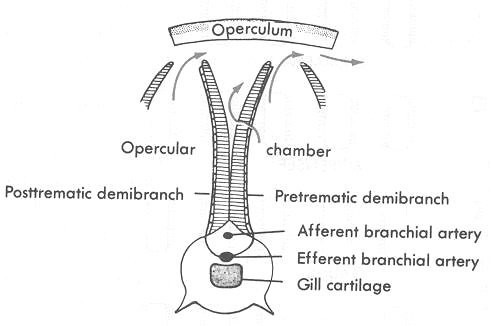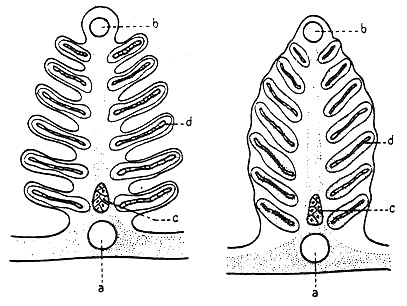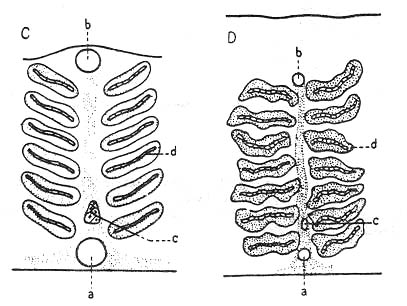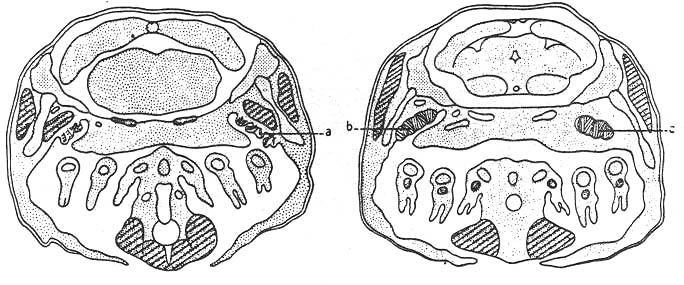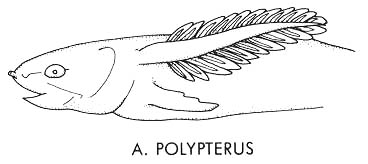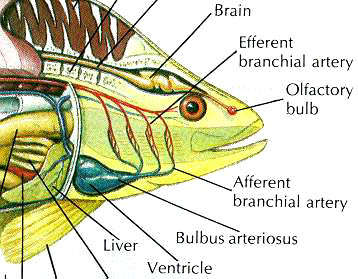![]()
I BACK I RETURN I NEXT I SUMMARY I Any Questions? I
![]()
Respiratory system û¼ýåÐïͧ
1. Gill
---Embryological consideration
--- Embryonal development of all vertebrates
--- Lateral wall of pharynx
---> Endodermal viseral sac and ectodermal visceral groove
---> a. Visceral clefts
---> (a) Hyomandibular clefts
--- Regression to spiracle in sharks and rays
Closure in teleosts
(b) Branchial clefts or gill slits
b. Visceral arches (Viscerocranium)
---> (a) Mandibular and hyoid arches
(b) Branchial or gill arches
# Visceral sac = Pharyngeal pouch
Visceral groove = Pharyngeal groove
--- Anatomical position
--- Within opercular cavity\ gill chamber\ branchial cavity
--- Respiratory and excretory functions
--- a. Respiration
--- Extraction of O2 \ Excretion of CO2
--- Other respiratory tissues
--- Skin\ Yolk sac\ Fins\ Gill covers
b. Excretion
(a) Nitrogenous metabolic wastes
(b) Exchange of univalent ions
---> Osmoregulation
--- Agnatha and elasmobranchii
--- Only breathing with gills
Many groups of osteichthyes
a. Gill
b. Other air-breathing organs
--- Lung as one type of air-breathing organ
--- Dipnoi and many teleostei
--- Associated with unfavorable alteration in the aqueous habitat
--- a. Drying-up
b. Oxygen-deficiency\ Formation of H2S
1) Path of the respiratory water (p 287)
|
| |
|
|
--- a. Teleosts
--- The simplest
b. Holocephali
--- Nasolabial groove or oral opening
---> Opercular gill slit
c. Elasmobranchii
--- Nasolabial groove\ Oral opening\ Spiracle or first gill slit
---> Orobranchial cavity
---> Gills
---> Parabranchial gill cavity
---> Gill-slits
--- Considerable variation in the agnatha
2) Internal gill
|
|
[Embryological consideration on the internal gill]
--- Special enlargements of the foregut epithelium
---> Respiratory part
<--- Entodermal tissue surrounging the branchial bones
--- a. Beneath a unitary gill cover in the teleosts and holocephali
b. In the gill slits in elasmobranchii/ gill pouches in agnatha
--- Attached to the gill arches of the visceral skeleton
--- a. Hypo-\ Cerato-\ Epibranchial skeleton
b. Often on the pharngobranchial as well
--- A double row on each bone
(1) Gill arches
--- 5 pairs in left and right side in osteichthyes
--- 6¡7 pairs in some chondricthyes
(2) Gill raker (Branchictenia, »õÆÄ)
--- No gill rakers in certain fish
--- Located on the medial lining of branchial arches
--- Grown-up on a cartilagenous or bony nucleus (Gill ray)
--- 2 rows originating from papillary projection of branchial mucosa
a. Oral row -+------------ Longer row of gill raker
b. Aboral row-+ ---> Generally called 'Gill raker'
--- Primary raker
--- Secondary lateral raker
--- Knobs on the sides of the primary raker
--- Rough surface of raker
--- Functions of gill raker
a. Mastication\ Aqusition of foods
--- Rakers
---> Formation of a gill filter (Plankton)
--- 3 types of filter
--- Long oral rakers in b and c
a. Biserial- symmetric
--- The most common type
b. Dimorph-monacanth -
c. Dimorph- polyacanth
b. Protection of gill filaments
|
|
|
(3) Gill filaments
--- No filaments in the last arch of osteichthyes
--- Only 4 pairs of gill archs are involved in respiration and feeding of foods (gill rakers)
a. Primary lamellae or filaments
--- Arrangement in a double-row on each bone
---> (a) Anterior or oral row
--- A hemibranch or half-gill
(b) Posterior or aboral row
--- Another hemibranch or half-gill
===> Holobranch or entire gill
--- Each hemibranch
---> Composed of a series of primary gill-filaments or foliae branchiales
b. Secondary lamella or Lamellae branchiales
# Synonyms
--- Respiratory platelets
Gill lamellae
--- Developed on both the superior and inferior surface of each filament
--- Perpendicular to the primary filaments
--- The bases of the secondary lamellae
---> Obliquely running to the longitudinal axis of the filament
--- Arrangement of secondary lamellae(Fig. 226)
(a) One single row on each surface
--- Perch\ Tinca Blica\ Chondrostoma
Pleuronectas platessa
(b) Double row on each surface
--- Anguilla\ Misgurunus\ Lucioperca\ Zoarces
2) Pseudogill or pseudobranch
--- No pseudobranch in anguilliformes
--- Separate gill located on the medial surface of the opercle or on the anterior wall of
hyomandibular cleft
--- No respiratory function
A few secondary lamella
--- Control of intraocular pressure
An endocrine organ associated with fulfilment of swimbladder gas and expansion of
melanophores
--- 3 types of pseudobranchs (Birtin's differentiation)
(1) Free type
--- Completely identical structure to normal gills
--- True hemibranch
(2) Covered type
--- 3 types according to the degree covered by connective tissue
Only in teleostei
(3) Embedded or submerged type (Cypriniformes)
3) Interbranchial septum(Gill septum)
--- Between anterior and posterior filaments of each branchial arch
--- a. Well-developed interbranchial septum
--- Sharks and rays
b. Regressive interbranchial septum
--- Teleostei
4) External gill
|
|
--- During the early development stages of some species, ie., embryonic or larval organs
--- Usually degenerated in the adult
--- a. Often long structures protruding into water alongside the body of the larva
b. The form of intrauterine respiratory and/or nutritive organs
--- Live-bearing species
--- Function
--- a. Respiratory
--- Often not exclusively
b. Nourishing the embryo
--- (a) From yolk of the egg
(b) From special uterine secretions in live-bearing species
(1) Entodermal external gill
--- Primarily in the elasmobranchii
--- Extremely elongated gill filaments(ex, Urolophus)
--- Projected out of the gill slits
--- Holocephali\ Chondrostei
--- Less-developed
Certain teleosts
--- Osteoglossomorpha
--- Gymnarchus\ Heterotis
(2) Ectodermal external gill
--- Dipnoi(Proptoterus\ Lepidosiren)
--- Formed exclusively by the skin
| <--- Development before the gill slits\ opercula
| --- Supplied with blood by the larval aortic arch or by the gill
| arteries which develop out of it
|
+---> Tuft- or tree-shaped structures
<--- Their own musculature
---> Always move to obtain a fresh supply of respiratory water
--- 3 types according to the systematic position of the species which have ectodermal external
gills
Proptoterus etc.
¨ç Remaining intact in the adult for a very long time(P. annectens)
¨è Found only in the larvae(P. aethiopicus)
--- Also polypteryformes(Branchiopterygii)
--- Polypterus\ calamoichthyes
¨é Intermediate type between ¨ç and ¨è(P. dolloi)
--- Found in only one species of teleostei
--- Acentrogobous(Gobidae)
Lepidosiren
--- Degenerated within a few days after hatching
Neoceratodus
--- Not any external gills
--- Often long structures which protrude into the water alongside of the larval body
2. Accessory respiratory organs
1) Organs of aquatic respiration
--- Young fishes during the gillless phase
--- a. Skin or body surface
b. Primordial fin
<--- A thin fold of skin
c. Gill cover in holocephali
d. Vascular network which develops around the yolk sac in embryos and larvae
2) Air-breathing organs
a. Lung(Dipnoi\ Polypteryformes)
--- A primitive type similar to that which existed when the lungs and swimbladders first began to
evolve
---> ¨ç Teleostean swimbladder
¨è Tetrapod's lung
--- Dipnoan lung
--- Not very efficient in the excretion of CO2, even in recent dipnoi
--- P. aethiopicus
--- Lung(About 90% of oxygen\ Not more than 57% of the CO2)
Gill(No more than 17%\ The rest of CO2)
--- Electric eels
--- Electrophorus electricus
--- The oral cavity(From the air)
--- Taking-up only 78% of the oxygen which the body requires
--- 81% of the CO2 releasing into the water through the skin
--- Strongly reduced gills in this species
b. Swimbladder
--- Never developed in the agnatha\ the lower gnasthomata, ie., the elasmobranchii and the
holocephali
c. Oral and branchial cavities
d. Gill-appendages\ Branchial papillae\ Special labyrinthine organs
e. Stomach\ Intestine
[Vasculature of the gill]
|
|
|
|
--- 2 kinds of vasculatures
--- a. Respiratory blood pathway
--- Arterio-arterial vasculature
b. Non-respiratory blood pathway
--- Arteriovenous vasculature
1) Respiratory blood vasculature
--- Ventral aorta
--- Afferent branchial artery
---> Afferent filamental artery
---> Afferent lamellar arteriole
---> Efferent lamellar arteriole
---> Efferent filamental artery
---> Efferent branchial artery
--->Dorsal aorta
2) Non-respiratory blood pathway
--- Efferent branchial artery (or efferent filamental artery)
---> Along the long axis of filament
---> Branchial vein (Nutrient vasculature)
![]()
I BACK I RETURN I NEXT I SUMMARY I Any Questions? I
![]()

